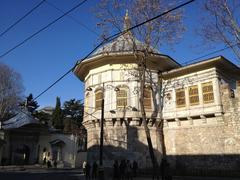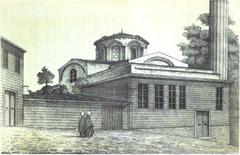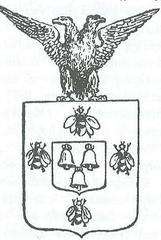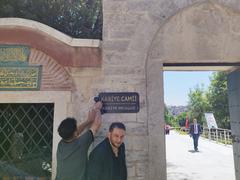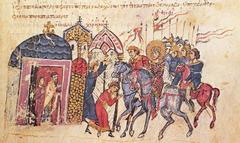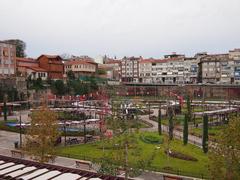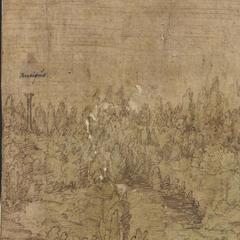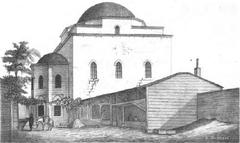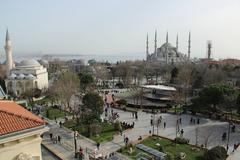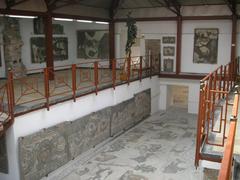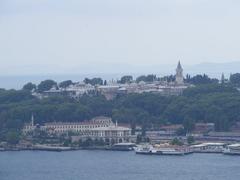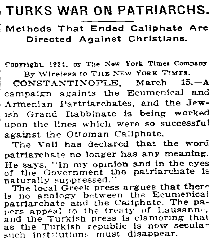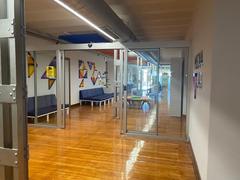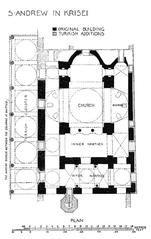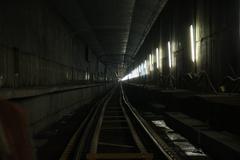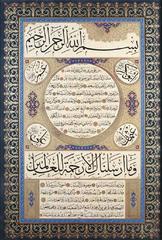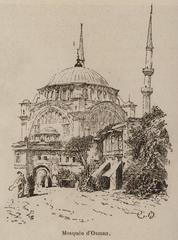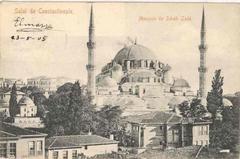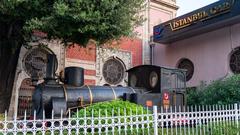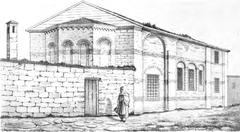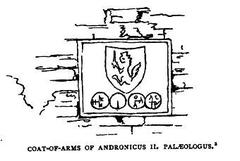
Sekbanbaşı Mosque: Visiting Hours, Tickets, and Visitor Guide in Fatih, Istanbul
Date: 04/07/2025
Introduction
The Sekbanbaşı Mosque, historically situated in Istanbul’s storied Fatih district, serves as a poignant testament to the city’s dynamic transformation from Byzantine to Ottoman rule. While the mosque itself was demolished in the mid-20th century and no longer stands, its legacy endures through historical narratives, archaeological records, and the enduring vibrancy of the surrounding neighborhood. This guide provides a comprehensive overview of the Sekbanbaşı Mosque’s historical background, architectural evolution, visitor information, and recommendations for exploring Fatih’s rich tapestry of cultural and religious landmarks (The Byzantine Legacy; Wikipedia).
Historical Overview
Byzantine Origins
The site of the Sekbanbaşı Mosque originated as a Middle Byzantine church, likely constructed between the 9th and 12th centuries CE. Located in the Kırkçeşme quarter near the Valens Aqueduct, the original church would have featured characteristic Byzantine architectural elements such as a cross-in-square plan and ornate interior decorations. Details on its specific dedication and appearance remain scarce, but its placement within this historic urban landscape highlights its importance during the Byzantine era (The Byzantine Legacy).
Ottoman Conversion
Following the Ottoman conquest of Constantinople in 1453, the building was converted into a mosque in the late 15th century by İbrahim Ağa, the lieutenant (sekbanbaşı) of the Ottoman sekban regiments. This transformation represented the broader spiritual and cultural reorientation of the city under Ottoman dominion. The mosque’s name is derived from its patron’s military title, reflecting a common Ottoman tradition in mosque naming (Wikipedia).
Decline and Demolition
The Sekbanbaşı Mosque endured significant damage from fires in 1838 and 1918. After the first fire, it was restored, but the destruction caused by the second led to its abandonment. In 1943, the remains were demolished to widen Atatürk Boulevard, and by 1954, modern apartment blocks occupied the site. Before demolition, archaeologist Semavi Eyice conducted a brief survey, preserving some record of the mosque’s foundations (The Byzantine Legacy).
Architectural Features
Byzantine Foundations
The original church likely embodied typical Middle Byzantine architecture, with a domed cross-in-square plan and masonry of brick and stone. Its proximity to the Valens Aqueduct situates it within a significant historical context (The Byzantine Legacy).
Ottoman Adaptations
Conversion to a mosque involved modifications such as the addition of a mihrab (prayer niche), minbar (pulpit), and removal or covering of Christian iconography. Specific records and images of these adaptations are limited (Wikipedia).
Later Modifications
Restoration after the 1838 fire likely introduced Ottoman repair techniques and materials, but the extent and nature of these changes remain unclear due to limited documentation.
Visiting Sekbanbaşı Mosque Today
Current Status
The Sekbanbaşı Mosque does not exist today; its original location is now occupied by residential buildings. As such, there are no visiting hours, tickets, or facilities specific to the mosque itself.
Exploring the Historic Footprint
While the mosque cannot be visited, the Fatih district remains a treasure trove of Ottoman and Byzantine heritage. Notable nearby sites include:
- Valens Aqueduct: A remnant of Roman engineering, just south of the former mosque site.
- Vefa Kilise Mosque: An example of a Byzantine church-turned-mosque.
- Süleymaniye Mosque: An architectural marvel of the Ottoman era.
- Grand Bazaar & Spice Bazaar: Iconic markets within walking distance (visitturkey.in; nomadicniko.com).
Getting There
The former site of the Sekbanbaşı Mosque is easily accessed via Istanbul’s public transportation. Tram line T1 (Vezneciler or Laleli-Üniversite stops) and various bus routes service the Fatih district.
Visitor Information for Mosques in Fatih
General Mosque Visiting Hours
Most active mosques in Fatih, such as Fatih Mosque and Süleymaniye Mosque, are open to visitors from early morning until evening (typically 8:00 AM to 5:00 PM or 6:00 PM), with brief closures during prayer times and extended hours during Ramadan (atriptoistanbul.com).
Entry and Dress Code
- Admission: Free; donations are welcomed.
- Dress code: Modest attire required. Women should cover hair, arms, and legs; men should avoid shorts. Shoes must be removed before entering the prayer hall (walksinistanbul.com; bluemosque.net).
- Photography: Permitted in non-prayer areas and when worship is not in progress.
Facilities and Accessibility
Facilities such as ablution areas and restrooms are standard in major mosques in Fatih. Accessibility varies; while some mosques offer ramps, historic structures may present challenges for visitors with limited mobility.
Exploring Fatih: Top Nearby Attractions
Ottoman and Byzantine Landmarks
- Fatih Mosque Complex: A monumental religious and civic center, including the tomb of Mehmed II (nomadicniko.com).
- Süleymaniye Mosque: Renowned for its harmonious design and panoramic views (turkeyvisaonline.com).
- Sehzade Mosque: An elegant work of Mimar Sinan, set in landscaped gardens (istanbulclues.com).
Multicultural Heritage
- Fener and Balat: Colorful neighborhoods reflecting Greek Orthodox, Armenian, and Jewish histories (istanbulclues.com).
- Remnants of the Church of the Holy Apostles: The predecessor to Fatih Mosque, once a major Byzantine basilica.
Markets & Culinary Experiences
- Grand Bazaar: A labyrinth of shops and local crafts (istanbulclues.com).
- Local Markets: Weekly street markets, especially lively on Wednesdays.
- Street Food: Simit, börek, kebabs, and Turkish delight abound (visitturkey.in).
Parks and Scenic Walks
- Gülhane Park: A lush, historical park ideal for relaxation (istanbulinvestments.com).
- Zeyrek-Vefa-Suleymaniye walking route: Traces Istanbul’s evolving architectural heritage (istanbulclues.com).
Cultural Events
- Whirling Dervish Shows: Experience the Sema ceremony at Hodjapasha, a unique spiritual performance (istanbulinvestments.com).
- Photography Museum: Exhibitions on Turkish visual culture (istanbulinvestments.com).
Practical Tips for Visitors
- Check Visiting Hours: For active mosques, plan your visit outside prayer times.
- Dress Appropriately: Modest clothing is mandatory; scarves are often provided at entrances.
- Respect Local Customs: Maintain silence, especially during prayers, and ask before photographing people.
- Stay Hydrated: Carry water, especially in summer.
- Safety: Fatih is generally safe, but remain vigilant in crowded areas.
Frequently Asked Questions (FAQ)
Q: Can I visit the Sekbanbaşı Mosque today?
A: No, the mosque was demolished in the 20th century; only its historical footprint remains.
Q: Are there visible remains or a memorial at the site?
A: No, there are no visible remains or memorials at the location.
Q: What are the visiting hours for nearby mosques?
A: Typically 8:00 AM to 5:00 or 6:00 PM, closed during prayers and religious holidays.
Q: Is there an entrance fee for mosques in Fatih?
A: No, entry is free; donations are appreciated.
Q: Are guided tours available in the district?
A: Yes, local operators offer guided walking tours that include major mosques and historical sites.
Visuals and Media Recommendations
To enhance your exploration, seek out historical illustrations or photographs of the Sekbanbaşı Mosque, images of the Valens Aqueduct, and maps of the Fatih district. Use alt tags such as “Sekbanbaşı Mosque historical site” and “Valens Aqueduct Istanbul” for SEO (The Byzantine Legacy).
Summary & Recommendations
Although the Sekbanbaşı Mosque no longer stands, its story is deeply woven into the fabric of Istanbul’s historic Fatih district. By exploring nearby mosques, markets, and multicultural neighborhoods, visitors can immerse themselves in centuries of Ottoman and Byzantine heritage. For the fullest experience, consider arranging a guided tour, downloading an interactive map, or using the Audiala app for real-time updates and curated audio guides (Official Istanbul Tourism Website).
Useful Links
- The Byzantine Legacy - Sekbanbaşı Mosque
- Wikipedia - Sekbanbaşı Mosque
- VisitTurkey.in - Fatih District
- Nomadic Niko - Fatih Mosque
- IstanbulClues - Best Walking Routes
- World History Journal - Istanbul Architecture
- TheTouristChecklist - Guide to the Blue Mosque
- ATripToIstanbul - Fatih Mosque
- ImamsOnline - Role of the Mosque in Community
- IslamicBrains - The Role of Mosques in Community
- Istanbul Official Tourism Website
- Audiala App
Plan Your Visit
For up-to-date information, maps, and audio guides, download the Audiala app. Follow us on social media for the latest tips and cultural highlights from Istanbul.



